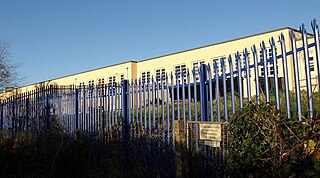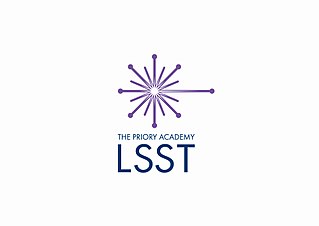
Lytchett Minster is a village in Dorset, England. It lies around 4 miles (6.4 km) north-west of Poole town centre. The village forms part of the civil parish of Lytchett Minster and Upton, Upton now being a suburb of Poole.

Purbeck was a local government district in Dorset, England. The district was named after the Isle of Purbeck, a peninsula that forms a large proportion of the district's area. However, it extended significantly further north and west than the traditional boundary of the Isle of Purbeck which is the River Frome. The district council was based in the town of Wareham, which is itself north of the Frome.

Beverley Grammar School is an 11–16 boys’ comprehensive secondary academy school in Beverley, East Riding of Yorkshire, England. A school may have been established under the Beverley Grammar School name about 700 AD; on that basis the school is claimed to be the country's oldest grammar school, and the eighth oldest school overall, but the existence of a school here is not continuous. The school shares a joint Sixth form with Beverley High School, styled as Beverley Joint 6th.
Horndean Technology College is a large school, situated in the village of Horndean in Hampshire, England. The school has formerly been called Horndean Community School, Horndean Secondary School and Horndean Bilateral. It is also sometimes informally referred to as Barton Cross, after the road on which its main entrance is situated. The school teaches over 1500 students a range of subjects, and has a large campus with over 11 buildings. The school has started a pilot scheme where they offer podcasts over the internet for at-home learning.

Torquay Girls' Grammar School is a selective grammar school for girls aged 11–18, in Torquay, Devon, UK. It is situated directly beside Torquay Boys' Grammar School, and became one of the first schools to achieve Humanities Specialist School status in September 2004, as well as one of the first to offer the AQA Baccalaureate. On 1 February 2011, the school officially gained academy status. It is a member of the South West Academic Trust – a collaboration of seven high-performing grammar schools and Exeter University. The examination results regularly place the school in the top twenty state girls' schools nationally.

The Priory Academy LSST is a co-educational non-selective academy school and teaching school situated on Cross O'Cliff Hill, Lincoln, Lincolnshire, England. It specialises in science, technology and teaching, and is the lead school of the Lincolnshire Teaching Schools Alliance. It is also the lead member of The Priory Federation of Academies.
Crompton House CE School is a coeducational Church of England secondary school and sixth form located in the High Crompton area of Shaw and Crompton in the Metropolitan Borough of Oldham, Greater Manchester, England.
Sir William Ramsay School is a co-educational secondary school in Hazlemere, Buckinghamshire. It takes children from the age of 11 through to the age of 18 with a total of approximately 1,180 pupils attending. The school shares a common catchment area with the nearby Holmer Green Senior School.

Finham Park School is a secondary school and sixth form with academy status. It is situated on Green Lane in Finham, Coventry, England.

Morecambe Bay Academy is a coeducational secondary school and sixth form located in Morecambe, Lancashire, England. It was founded as Morecambe Grammar School in 1919, moving to its current site on Dallam Avenue in 1938 on a former golf links course. In 2019, it was renamed to Morecambe Bay Academy during the process of becoming an academy.

Churston Ferrers Grammar School is a selective coeducational Grammar School with Academy status, situated in the village of Galmpton in Torbay, South Devon, England. It is also a specialist Humanities College. Year 7 annual intake is approximately 130 pupils.

Holcombe Grammar School is a grammar school with academy status in Chatham, Kent, England. They are part of Thinking Schools Academy Trust. Holcombe is a selective school. From the 2017-18 academic year, the school planned to become co-educational and remain selective in the lower school. This was blocked - and later approved - by the Department for Education with co-educational admission desired for the 2018/19 school year. The school has changed name in their advanced plans of becoming co-educational and plans to change all references from "Chatham Grammar School for Boys" to "Holcombe Grammar School" over academic year 2016/17.

Woodkirk Academy is an academy located in Tingley, West Yorkshire, England. Established in 1948, the school now has over 1,800 pupils on roll, over 300 sixth form students and over 250 members of staff. Following Woodkirk gaining ‘Specialist Science Status', the school was briefly renamed Woodkirk High Specialist Science School from 2003 to 2011.
Ashmole Academy is a secondary school with academy status in Southgate, England in the London Borough of Barnet. Under the direction of the headteacher Balbinder Dhinsa, around 1,800 pupils are educated in ages 11–18.
St Bede's Inter-Church School is the only Christian state secondary school in Cambridgeshire. It is an academy school with support from both the Roman Catholic Diocese of East Anglia and Anglican Diocese of Ely. The school currently has around 750 pupils and around 50 staff.

St Thomas More Catholic School is a Roman Catholic secondary school with academy status in Blaydon, Tyne and Wear, England, providing teaching to 11- to 19-year-olds. It is a well-regarded and over-subscribed school, performing well both regionally and nationally. In its most recent OFSTED inspection (2023) it was credited with having cultivated a "climate of high ambition" and was rated as "good" in all major areas assessed. The school converted to academy status on 1 February 2012.
Park House School is a secondary school in Newbury, Berkshire in the United Kingdom. It accepts students aged 11–18 and currently has approximately 1,300 students on roll including a sixth form of around 300. On 1 May 2011, Park House School became an independently run Academy. It was formerly a comprehensive school run by the West Berkshire Education Authority. The schools latest Ofsted inspection rated PHS as ‘Inadequate’
The Corsham School is a large secondary school, with a sixth form, in Corsham, Wiltshire, England. The school has academy status, and as of January 2022 has 1,129 pupils enrolled.
Oak Academy is a co-educational secondary school located in the northern outskirts of Bournemouth in the English county of Dorset.
Teign School is an 11–18 academy school located in Kingsteignton, a town to the north of Newton Abbot. The original 1936 building has been expanded upon substantially and numerous additional buildings have been constructed within the grounds. The school has entry level at Year 7. The school also has a sixth form centre. In 2004 it was awarded specialist Science status by the Specialist Schools Trust. The most recent Ofsted inspection was on 16 April 2015 which resulted in a 'good' rating.











